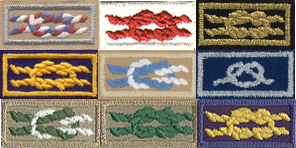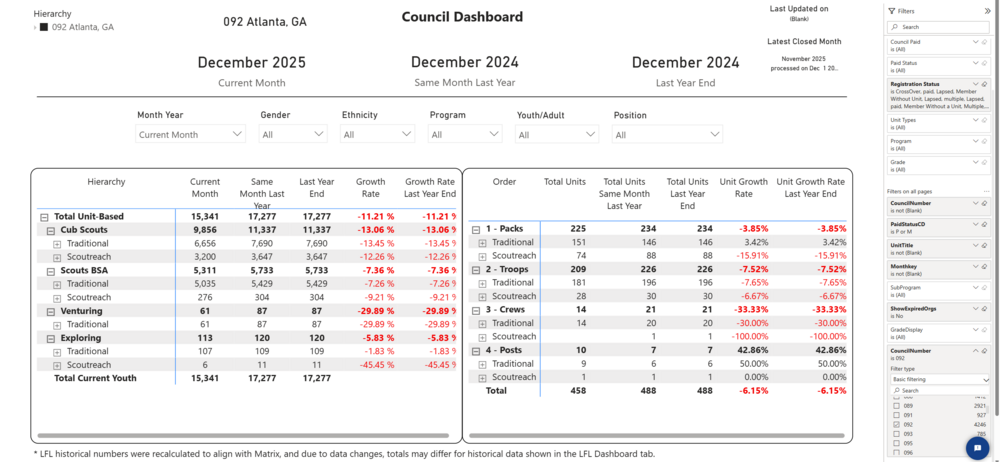
InquisitiveScouter
Members-
Posts
2643 -
Joined
-
Last visited
-
Days Won
125
InquisitiveScouter last won the day on December 23 2025
InquisitiveScouter had the most liked content!
Profile Information
-
Gender
Male
-
Location
Savoir Faire is Everywhere!
-
Occupation
Retired
-
Interests
Scouting
-
Biography
Eagle Scout, plus a whole lot more ;)
InquisitiveScouter's Achievements

Senior Member (3/3)
1.9k
Reputation
-
Cost of Scouting vs Cost of Sports
InquisitiveScouter replied to NealOnWheels's topic in Issues & Politics
Sorry, I put this in the wrong thread... ------------------------------------ The biggest unadvertised cost of Scouting is the amount of volunteer adult support it takes to make a good unit level program happen. No "pitch" that I have ever heard (outside of our unit) tells parents that "We welcome your kids, but you have to come along, too, to help us put on the program." When you do get them to agree to help, then explain that "help" means a variety of getting trained, learning Scout skills so that you know what 'right' looks like, being a merit badge counselor, serving on the committee to help with budget, managing adult training, onboarding, advancement, uniforming, equipment, fundraising, etc, etc, etc, Oh, and we need drivers and adults for camping, too. Once they learn those needs, many are out. They want to take their kids to programs where they can dump and run, or show up occasionally with a tray of orange slices and some juice boxes. Once upon a time, when I served Uncle Sam, our mantra in the Air Force was "We recruit Airmen, but we retain families." And we did PR, ads, benefits, and programs to support that. Attract individuals, but make our environment such that, as they start a family while serving (which many do), we make it comfortable for their family to have the service member stay in. (This mindset varies across the services, though many of the family programs and benefits are duplicated in all services. Health care, base housing, commissary and exchange, MWR [morale, welfare, and recreation], etc. ) Scouting should be, "We recruit families, but we retain the Scout." Get the family on board, and give them benefits for their Scouts (a program of adventure) , and the youth will stay, keeping the parents involved. -
The biggest unadvertised cost of Scouting is the amount of volunteer adult support it takes to make a good unit level program happen. No "pitch" that I have ever heard (outside of our unit) tells parents that "We welcome your kids, but you have to come along, too, to help us put on the program." When you do get them to agree to help, then explain that "help" means a variety of getting trained, learning Scout skills so that you know what 'right' looks like, being a merit badge counselor, serving on the committee to help with budget, managing adult training, onboarding, advancement, uniforming, equipment, fundraising, etc, etc, etc, Oh, and we need drivers and adults for camping, too. Once they learn those needs, many are out. They want to take their kids to programs where they can dump and run, or show up occasionally with a tray of orange slices and some juice boxes. Once upon a time, when I served Uncle Sam, our mantra in the Air Force was "We recruit Airmen, but we retain families." And we did PR, ads, benefits, and programs to support that. Attract individuals, but make our environment such that, as they start a family while serving (which many do), we make it comfortable for their family to have the service member stay in. (This mindset varies across the services, though many of the family programs and benefits are duplicated in all services. Health care, base housing, commissary and exchange, MWR [morale, welfare, and recreation], etc. ) Scouting should be, "We recruit families, but we retain the Scout." Get the family on board, and give them benefits for their Scouts (a program of adventure) , and the youth will stay, keeping the parents involved.
-
Another facet of this that may arise under the new registration system... We have several units who cannot be renewed because the leaders have not renewed. Yet, those units have Scouts who renewed online for 2026. I hope the number will be small, but for a time, we are going to have Scouts with current registrations whose units have shuttered. They'll need to find new homes.
-
The system numbers I see tell a different story. As promised, 01 Jan numbers, pulled moments ago... Total Current Youth: 855,685 (Jan 2026) a 14.22% drop from Jan 2025 Same Month Last Year: 997,529 (Jan 2025) Last Year End: 907,949 (This is the 31 Dec 2025 number in the system.) Dec 2024 End of Year number was: 986,520 So, Dec 2025 year end compared to Dec 2024, is a 7.96% drop, year to year. These numbers include Learning for Life...about 27K on the books now. And, um, how is hiring an Executive VP of Membership (LOL) going stop the losses? Or hiring "unit growth executives" at the council level??? Explain it to me like I was a ten year old (who might be looking to join Scouting), please
-
Safeguarding Youth Test (Not a Survey)
InquisitiveScouter replied to InquisitiveScouter's topic in Issues & Politics
Hey man, we only get to work when things become a Crisis. So, until it becomes a crisis, we ain't doin' nothin'. If you follow our philosophy, then all you have to do is Crisis Management. And when it becomes a Crisis, if you don't want to deal with it, then dump it on someone else and find a new position elsewhere. We just pray there are plenty of fat paychecks in the bank before the Crisis rears its ugly head, and we have to leave. (not having done the Crisis Management we have said we would do 😜 ) Now, pay us your fees and go have fun!! -
Just got this "survey" request through email. But, it is not a survey... it is a test of your knowledge and application of Safeguarding Youth policies and procedures. Incorrect to call it a survey... a survey asks for your opinion or perspective on things. This was just a 22-question outright multiple choice exam. Ignorant? Manipulative? Misleading? Deceptive? I'll apply Hanlon's Razor and move on... https://www.britannica.com/topic/Hanlons-razor NOTE: Link removed as it may be user-unique... Dear Scouting America Member, At Scouting America, safeguarding our youth isn’t just a priority—it’s central to preparing young people for life. Your perspective and input helps strengthen the safe, supportive environment that families expect from our programs. As part of our continuing effort to strengthen our safeguarding efforts, Scouting America is working with USA Child, a nonprofit think tank devoted to ending child abuse and neglect, on evidence-based solutions to issues related to safeguarding youth. Your input in this process is critical. Please take a few minutes to complete USA Child Research’s brief, anonymous child‑safety survey. Deadline to complete the survey is December 31, 2025. Click here to start the survey: Thank you for taking the survey and for all you do to keep kids safe. Glen Pounder Chief Safeguarding Officer Scouting America
-
I'd be interested to know the source... I pulled raw numbers from the Council Membership Tool on my.scouting. See attached for today's report on 092, Atlanta Area Council, which @Jameson76 had asked for. So, over five days, the current numbers changed to 15341, up from 15315 last Friday (+26). You'll notice the Dec 2024 number does not change (nor should it). The number this will be on 31 Dec, as @Eagle94-A1 points out, will be the one to watch for to give the most accurate "real time" number for comparison. Although, I suppose if a Registrar has a backlog of applications or renewals, they can tweak the Dec 2025 numbers into Jan 2026.
-
Another pet peeve... Scout camps that are not designed around the Patrol Method. What we have mostly these days is a Troop-amoeba campsite with individual Scouts doing their own individually tailored programs during the day. And, they are being given merit badges without having done the work. (Yes, there are exceptions, but this is the general rule, in my observation...) The hidden message is that advancement is the primary purpose of Scouting. If the flagships of the councils, the council-run Summer Camps, are not pushing the Patrol Method, then they work at cross-purposes with units who are trying to do it that way.
-
We are not making participation mandatory for Scouts or parents. In Scouting, there really isn't "skin in the game" unless you want to put it there. Yes, this is it. When I had the reins of the Troop, we went camping every month, with two or three big events every summer... 50-miler backpacking trips, week-long beach adventures, 50-miler canoeing, 100+ mile cycling trips, etc. Now that I have pulled back a lot from the Troop, there is no one who is willing to put that much effort into the program. So, the numbers are dwindling. Agree with you wholeheartedly... young men want adventure, not academics.
-
Here are our costs for 2026: 2026 Unit Charter Fee - $100.00 ------------------------------------- 2026 National Membership Fee - Youth $85.00 2026 Council Service Fee - Youth $75.00 2026 Troop Dues - $35.00 2026 Sibling Discount - $17.50 2026 One-time Equipment/Joining Fee - $35.00 --------------------------------------------- 2026 National Fee - Adult $65.00 2026 Council Insurance Fee - Adult $6.00 So, cost to remain in the Troop for 2026 if you are already registered? $85 + $75 + $35 = $195 (Don't forget to add on National's credit card fee, if you pay through my.scouting) Cost to transfer/crossover to the Troop in say, March 2026 (because they already registered with their Pack)= ($35/12 * 9) + $35 = $61.25 {That's Troop dues pro-rated, and the Troop equipment fee.) We used to pay these fees for the entire Troop from our bank account around 01 Dec thru the re-charter process. We would then assess the costs to each Scout through Scoutbook to collect. For several of our families, we would "carry" that debt for a few months until all the Christmas / New Years bills were paid. If a Scout's balance goes over $200, we ask for some partial payment to bring it back below $200. Troop has 44 Scouts currently. Eight will not renew (Seven are turning 18 years old, and one is dropping out.) Now, here we are on 15 Dec, and 25 out of 36 eligible Scouts do not have a renewed registration. That's 69.4% whose parents have ignored the emails from National to renew. (...and our one Troop reminder at the beginning of the month.) National sent emails on 01 Nov and 01 Dec. Committee has not discussed what to do in the New Year with Scouts who have not renewed registrations.
-
North Carolina includes: Last Dec / This Dec / % change 070, Old North State, Greensboro: 3284 / 2794 / -14.82% 414, Daniel Boone, Asheville: 1381 / 1244 / -9.92% 415, Mecklenburg County, Charlotte: 4380 / 4286 / -3.29% 416, Central NC, Albemarle: 2541 / 2546 / +0.20% 420: Piedmont, Gastonia: 3903 / 3702 / -5.15% 421, Occoneechee, Raleigh: 8170 / 8189 / +0.23% 424, Tuscarora, Goldsboro: 1839 / 1351 / -26.54% 425, Cape Fear, Wilmington: 2125 / 1954 / -8.05% 426, East Carolina, Kinston: 2597 / 2355 / -9.32% 427, Old Hickory, Winston-Salem: 2586 / 2468 / -4.56% And I'll include 596, Tidewater, Virginia Beach, VA, which extends down into NC: 3934 / 3777 / -3.99% And in the aggregate, all those councils: 36740 / 34616 / -5.78%








